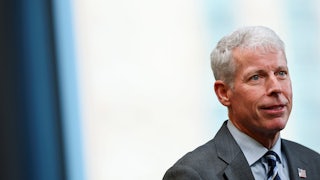Climate change is on track to cause $38 trillion worth of damages worldwide by 2049. That’s according to a study published this week in Nature by researchers at Germany’s Potsdam Institute for Climate Impact Research. That outcome is likely regardless of how quickly emissions are reduced before then, as the “net benefits of mitigation only emerge in the second half of the century.” Failing to take adequate action before midcentury could increase the costs of climate destruction threefold through the rest of the century, reducing global incomes by 60 percent below what might be expected in a world without rising temperatures.
So what are the institutions ostensibly created to protect the world’s economic health—the International Monetary Fund and the World Bank, which conclude their annual spring meetings in Washington, D.C., this week—doing to avert this catastrophic outcome?
The headline announcement from World Bank head Ajay Banga this week was that the bank has lowered its equity-to-loan ratio from 20 percent to 19 percent, freeing up another roughly $4 billion per year by allowing it to lend more freely. It pledged, as well, to boost its share of total annual climate finance by 10 percent, from 35 to 45 percent. Banga downplayed what the institution he runs, or the countries that comprise its membership, could do to bridge the $2.4 trillion climate finance gap on their own, emphasizing the need for corporations to step up. “The only way forward,” he told CNN’s Fareed Zakaria in an interview this week, “is to find a way to get the private sector to believe that this is part of their future.”
The private sector isn’t so sure. JP Morgan Chase—the bank that’s financed more fossil fuel development than any of its competitors since the Paris Agreement was signed—concluded that moving from hydrocarbons to renewables just isn’t a good enough deal. In a strategy report sent out to clients this week, the bank said that those pushing for more ambitious climate targets were in need of a “reality check”: Renewable energy, the report noted, “currently offers subpar returns.” The energy consultancy Wood McKenzie similarly found that higher interest rates are making wind, solar, and other low-carbon energies look “even harder and more costly” to those who might fund them.
In other words, despite the staggering figure published in Nature, today’s titans of industry are gambling that they’ll be sufficiently insulated from the economic chaos wrought by rising temperatures, and that they therefore don’t need to worry about how they’re contributing to that phenomenon or the consequences for their bottom lines. They’re companies, though: The only thing we can reasonably expect them to do is to try to make as much money as possible, as quickly as possible. The trouble is people who should know better assuming they’ll do anything else.
The common wisdom in institutions like the World Bank—shared by top U.S. climate officials—is that the key to “mobilizing private finance” is to make the elements of adaptation and (especially) mitigation efforts “bankable.” If projects cannot on their own generate enough returns to satisfy potential investors, then governments will need to step in and supplement, or “de-risk,” those returns. That approach can go a long way for projects on the road to profitability that need a little push—say, electric vehicle production in the United States. But building a comprehensive zero-carbon grid in some of the world’s poorest countries might never be profitable enough to coax Wall Street into coughing up cash. That’s especially true given that poorer and middle-income countries in the global south now face the worst debt crisis since record-keeping on those figures began. More than three billion people now live in countries that pay more for debt service than health care and education; subsidizing private-sector returns on wind and solar farms probably isn’t at the top of the list in those places, particularly if loan packages require such states to boost oil and gas development.
Banga and other top decision-makers who frequent spring meetings and U.N. climate talks are pretty Pollyannaish about prospects for low-carbon development despite plenty of evidence to the contrary. They insist on presenting climate action as a win-win that promises higher profits for all. It’s an attractive fantasy. But the rich countries that make up the majority shareholders of the World Bank, particularly the U.S., have routinely sought to avoid the historical and distributional questions at the heart of the climate challenge: Who bears the most responsibility and the most risk? In other words, if $38 trillion in climate damages are coming down the pike, who’ll foot the bill? In continuing to punt those question down the road, hoping for private-sector generosity while neglecting structural fixes, they seem to have come up with the same answer as the banks: someone else.








